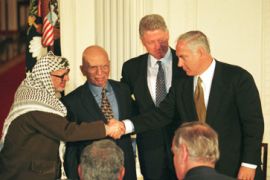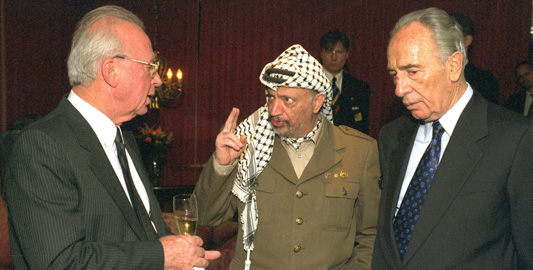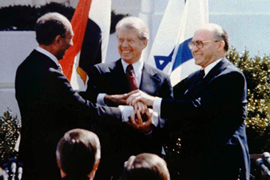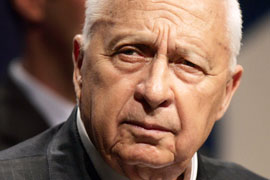Milestones of war and peace
A timeline of key events in the Arab-Israeli peace process since 1967.

 |
| In this file photo, Palestinian leader Yasser Arafat talks with Israeli Prime Minister Yitzhak Rabin, left, and Israeli Foreign Minister Shimon Peres after they were awarded the Nobel Peace Prizes in 1994 [GALLO/GETTY] |
In the years following the Arab defeat during the Six-Day War in 1967, the UN and other groups worked to push the warring parties towards opening channels for dialogue which would blossom into full-fledged peace treaties.
The UN passed dozens of resolutions condemning the violence, tit-for-tat attacks between Israelis and the Arabs, and endorsed peace plans that have come and gone.
The following are key events in the development – and ultimate failure – of several peace intiatives in the past 41 years.
November 22, 1967: Following the Six-Day war between Israel and the Arabs, the UN Security Council passes resolution 242 and expresses “its continuing concern with the grave situation in the Middle East, emphasising the inadmissibility of the acquisition of territory by war and the need to work for a just and lasting peace in which every state in the area can live in security”.
The resolution becomes the basis for all future peace treaties, agreements and accords.
February 14, 1969: The fifth Palestinian National Council meeting convenes in Cairo. Yasser Arafat, leader of the Palestine Liberation Organisation (PLO), is declared chairman of the executive committee, effectively becoming head of the Palestinian movement.
June 25, 1970: William Rogers, US secretary of state, launches an initiative for peace in the Middle East, later known as the Rogers Plan.
It is described as an encouragement to Israel and the Arabs to move towards a just and lasting peace by means of a final settlement.
Gamal Abdel Nasser, Egypt’s president, accepts the plan as a way of reducing Egyptian-Israeli hostilities.
October 6, 1973: Egypt and Syria attack Israeli forces in the Sinai and Golan Heights on Yom Kippur, the Jewish day of atonement, hoping to reclaim territory lost in the Six-Day war. T
hey make initial gains but are forced to retreat after an Israeli counterattack.
After regaining the territory, Israel’s prime minister Golda Meir resigns.
November 9, 1977: Anwar Sadat, Egypt’s president, astonishes the world when he turns up in Israel, the first Arab head of state to recognise and visit Israel.
 |
| Sadat, left, US President Jimmy Carter, and Israeli PM Menahem Begin make peace in 1979 |
Addressing the Israeli parliament, the Knesset, Sadat urges that UN resolutions 242 and 338 be implemented by Israel to convince the Arabs to come to the negotiating table.
Though Israel does not adopt the resolutions, Sadat’s speech paves the way for the Camp David accords signed between Egypt and Israel under US sponsorship.
The accords become the cornerstone for the first peace treaty between Israel and an Arab country.
It is signed on March 26, 1979, formally ending the state of war between the two sides.
August 7, 1981: Fahd bin Abd al-Aziz, Saudi Arabian Crown Prince – later to become King Fahd of Saudi Arabia, announces an initiative for peace in the Middle East.
The initiative consists of eight articles of intent, including an implicit recognition of Israel. It mentions the right to exist for all Middle Eastern countries, and is based mainly on UN resolution 242. The initiative calls for a Palestinian state with East Jerusalem as its capital.
(But Israel annexes East Jerusalem a year later.)
In November 1981, the initiative is officially submitted to the first Arab Summit in Fez, Morocco, but fails to win majority approval.
Fez hosts another Arab summit in 1982 and the initiative is resubmitted and is approved by an overwhelming majority.
June 6, 1982: Israel invades Lebanon and occupies its southern region causing a furore in the Arab world. All diplomatic peace initiatives are suspended.
The Israeli army allows the newly created Christian SLA (South Lebanon Army) to carry out massacres and commit human-rights abuses.
November 23, 1984: The Palestinian National Council holds its 17th session in Amman, Jordan.
 |
| A Palestinian boy holds a portrait of Arafat [AFP] |
King Hussein of Jordan delivers a speech urging conferees to agree on a Jordanian–Palestinian peace initiative, based on UN resolution 242.
The Palestinian leadership, startling the world, announces that the PLO is considering dropping armed resistance against Israel and could agree to live side by side with an Israeli state if Israel were to pull out from the Palestinian territories occupied since 1967.
The Arab states start intensive diplomatic efforts to reach a compromise with Israel on this.
In 1985, Jordan and the PLO agree on co-federalism in a bid to form a pan-Arab formula for peace in the Middle East.
The formula stipulates that lands recovered from Israeli occupation would be annexed to Jordan under a federation system. But efforts collapse when Israeli warplanes bomb PLO headquarters in Tunis.
December 9, 1987: An intifada (popular uprising) among the occupied Palestinian population begins. Hundreds of thousands of Palestinians, including women, children and teenagers take part.
The symbol of the intifada becomes the stone-throwing children confronting the Israeli army.
Between December 1987 and September 1993 (the Declaration of Principles Agreement) thousands of Palestinians are killed, with the UN reporting the Palestinian death ratio at 25 to 1 Israeli during this first intifada.
March 6, 1991: The US, fresh from victory in the first Gulf war, announces an initiative for peace in the Middle East to take place in the autumn of that year.
October 30: An international peace conference, co-sponsored by the US and the Soviet Union and with Israeli and Arab delegates, is convened in Madrid, Spain.
The talks do not prove successful, yet it leads to secret meetings in Oslo, Norway, between the PLO and Israeli officials and makes promising progress.
September 13, 1993: The PLO and Israel officially recognise each other by signing a Declaration of Principles (DoP) in Washington, DC.
The agreement, drawn up in Oslo, stipulates that during a five-year interim period, Palestinians would gradually be handed the administration of the West Bank and Gaza, and continue to negotiate a permanent peace treaty to settle on the final status of the occupied territories.
July 1, 1994: Arafat returns to the Gaza Strip, Palestine, after 27 years in exile and is to head an interim administration of the new Palestinian Authority.
October 26: Jordan and Israel sign the Treaty of Peace in Araba Valley, Jordan, to become the second Arab state after Egypt to end the state of war with Israel.
As in 1993, the peace treaty is backed by diplomatic moves by the US.
September 24, 1995: Arafat and Israeli Foreign Minister Shimon Peres sign the Taba Agreement.
The agreement sets up the mechanism for a transitional period towards Palestinian self-rule in the Gaza Strip and the West Bank, during which Palestinians will assume control over Palestinian towns and villages, and consequently ends a 28-year occupation there.
November 4: Israeli premier Yitzhak Rabin is assassinated by a Jewish extremist. Peres becomes prime minister.
December 11: Peres spells out his notion of a “grand peace” based on Israeli withdrawal from the Golan Heights (occupied by Israel since the 1967 conflict), in return for full normalisation of relations with Syria and the Arab states.
Hafez al-Assad, the Syrian president, responds positively to the initiative.
June 22, 1996: Arafat wins elections and is sworn in as Palestinian president.
October 23, 1998: Following a 19-month deadlock, during which Israelis and Palestinians exchange accusations of disrupting the peace process, the Wye River Memorandum is signed in the US, promising Palestinians faster and further autonomy.
A revised accord is signed in September kickstarting fresh talks.
May 22, 2000: Battered by frequent attacks mounted year on year by Islamist resistance group Hezbollah (Party of God), Israel’s prime minister Ehud Barak announces a hasty withdrawal of Israeli troops from southern Lebanon, after 22 years of occupation.
July 25: A marathon summit hosted by Bill Clinton, the US president, between Barak and Arafat at Camp David collapses when they fail to agree on, among other things, the future status of Jerusalem.
September 28-29: In a highy provocative move, Ariel Sharon, the Israeli housing minister at the time, visits al-Aqsa mosque, sparking a violent reaction from Palestinians.
 |
| Ariel Sharon’s visit sparked the second intifada |
The Palestinians are outraged that the man they hold responsible for the 1982 Sabra and Shatila massacres in Lebanon is visiting the Aqsa mosque compound.
Violent protests ensue.
The peace process in the Middle East receives a deadly blow as Israel reoccupies the Palestinian territories amid fighting between the Palestinian and Israeli army.
A second intifada begins which, according to Israeli human rights organisation BTselem, kills 2171 Palestinians and 194 Israelis by October 15, 2003.
October 17: Egypt hosts the Sharm al-Sheikh peace summit.
The summit announces a plan to bring weeks of Israeli-Palestinian confrontation to an end.
The plan does not succeed.
May 21, 2001: George Mitchell, a former US Senator releases his long-awaited report (the Mitchell Plan) on the Middle East conflict.
It calls for a ceasefire, confidence-building measures and, ultimately, negotiations.
June 16, 2002: Israel begins construction of its wall to enclose the West Bank.
September 20: Israel besieges Arafat’s headquarters in Ramallah, demolishing most of his office complex and confining him there, while simultaneously embarking on a policy of extra-judicial assassinations and imprisonment of Palestinian leaders.
February 26, 2003: Israel begins a series of incursions (repeated throughout the year) that lead to the reoccupation of parts of the Gaza Strip and the West Bank, inflicting widespread damage and heavy civilian casualties.
|
Related link |
February 27: Abdullah bin Abd al-Aziz, Crown Prince of Saudi Arabia, announces an Arab peace initiative in the Middle East.
The plan insists on Israeli withdrawal from the occupied territories in return for Arab recognition of Israel’s right to exist.
A similar version but with reservations is adopted later by the Arab League.
April 29-30: Following the invasion of Iraq by the US and allied occupation forces, Arafat, under intense international pressure, allows the election of Mahmoud Abbas as Palestinian prime minister to embrace a reform and peace agenda.
The Israelis and Palestinians receive the long overdue, heavily promoted “road map” formula for peace, internationally backed by the quartet of the US, Russia, the European Union and the United Nations.
June 4: Sharon and Abbas meet at Aqaba, Jordan, to discuss the implementation of the peace road map.
March 22, 2004: Sheikh Yassin, the founder and leader of Hamas, is assassinated by an Israeli helicopter gunship.
November 11: Arafat dies.
January 9, 2005: Mahmoud Abbas is elected president of the Palestinian National Authority.
January 25, 2006: Hamas wins a majority of seats in the Palestinian legislative election.
The US, Israel and several European countries cut off their aid to the Palestinians as the movement rejects Israel‘s right to exist.
February 8, 2007: Hamas and Fatah agree on a deal in Mecca to end factional warfare that has killed scores of Palestinians and to form a coalition, hoping this would lead Western powers to lift crippling sanctions imposed on the Hamas-led government.
February 9: The Quartet welcomes the role of the Kingdom of Saudi Arabia in reaching the agreement to form a Palestinian National Unity government but later reaffirms that it must obey international demands to recognise Israel, renounce violence and abide by previous peace agreements.
March 17: The new Palestinian unity government holds its first cabinet meeting in Gaza City, with ministers in the West Bank participating from Ramallah via video link.
March: Israel refuses to talk to the coalition, saying it fails to meet international demands – renouncing violence, recognising Israel and honouring past peace deals.
November: George Bush, US president, hosts peace talks between Palestine and Israel at Annapolis, Maryland, while Hamas still holds control over Gaza.
January, 2008: Israel steps up military actions on Gaza and Hamas, killing seven Palestinians. Olmert vows to hit back after Hams rocket attacks in Israel. Israel continues powerful incursion on Gaza, leaving Palestinians in a humanitarian crisis without fuel, power, food and water.